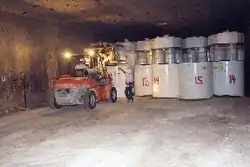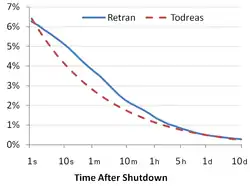Portal:Nuclear technology
The Nuclear Technology Portal
Introduction

- Nuclear technology is technology that involves the nuclear reactions of atomic nuclei. Among the notable nuclear technologies are nuclear reactors, nuclear medicine and nuclear weapons. It is also used, among other things, in smoke detectors and gun sights. (Full article...)
- Nuclear power is the use of nuclear reactions to produce electricity. Nuclear power can be obtained from nuclear fission, nuclear decay and nuclear fusion reactions. Presently, the vast majority of electricity from nuclear power is produced by nuclear fission of uranium and plutonium in nuclear power plants. Nuclear decay processes are used in niche applications such as radioisotope thermoelectric generators in some space probes such as Voyager 2. Generating electricity from fusion power remains the focus of international research. (Full article...)
- A nuclear weapon is an explosive device that derives its destructive force from nuclear reactions, either fission (fission bomb) or a combination of fission and fusion reactions (thermonuclear bomb), producing a nuclear explosion. Both bomb types release large quantities of energy from relatively small amounts of matter. (Full article...)
General images -
Selected article -

The Alsos Mission was created after the September 1943 Allied invasion of Italy as part of the Manhattan Project's mission to coordinate foreign intelligence related to enemy nuclear activity. The team had a twofold assignment: search for personnel, records, material, and sites to evaluate the above programs and prevent their capture by the Soviet Union. Alsos personnel followed close behind the front lines in Italy, France, and Germany, occasionally crossing into enemy-held territory to secure valuable resources before they could be destroyed or scientists escape or fall into rival hands.
The Alsos Mission was commanded by Colonel Boris Pash, a former Manhattan Project security officer, with Samuel Goudsmit as chief scientific advisor. It was jointly staffed by the Office of Naval Intelligence (ONI), the Office of Scientific Research and Development (OSRD), the Manhattan Project, and Army Intelligence (G-2), with field assistance from combat engineers assigned to specific task forces.
Alsos teams were successful in locating and removing a substantial portion of the German research effort's surviving records and equipment. They also took most of the senior German research personnel into custody, including Otto Hahn, Max von Laue, Werner Heisenberg and Carl Friedrich von Weizsäcker. (Full article...)
Selected picture -

Did you know?
- ... that the 2015 children's picture book Timeline chronologically illustrates major world events, including the Big Bang and the Fukushima nuclear disaster?
- ... that the W71 nuclear warhead had a tamper made of gold?
- ... that although John Foster long ago described heavy ion fusion as "the conservative approach" to a working fusion reactor, no large-scale system has ever been built?
- ... that Earth 300 has designed a climate research vessel that would include a molten salt reactor and a quantum computer?
- ... that coral cores from Flinders Reef capture environmental changes caused by the use of nuclear weapons?
- ... that on 18 October 2020, all previous United Nations arms resolutions on Iran expired based on Security Council Resolution 2231?
Related WikiProjects
- WikiProject Energy
- WikiProject Technology
- WikiProject Military history
Things you can do
| Parts of this portal (those related to section) need to be updated. Please help update this portal to reflect recent events or newly available information. Relevant discussion may be found on the talk page. (September 2021) |
|
|
Here are some Open Tasks :
|
Selected biography -

Bush joined the Department of Electrical Engineering at Massachusetts Institute of Technology (MIT) in 1919, and founded the company that became the Raytheon Company in 1922. Bush became vice president of MIT and dean of the MIT School of Engineering in 1932, and president of the Carnegie Institution of Washington in 1938.
During his career, Bush patented a string of his own inventions. He is known particularly for his engineering work on analog computers, and for the memex. Starting in 1927, Bush constructed a differential analyzer, an analog computer with some digital components that could solve differential equations with as many as 18 independent variables. An offshoot of the work at MIT by Bush and others was the beginning of digital circuit design theory. The memex, which he began developing in the 1930s (heavily influenced by Emanuel Goldberg's "Statistical Machine" from 1928) was a hypothetical adjustable microfilm viewer with a structure analogous to that of hypertext. The memex and Bush's 1945 essay "As We May Think" influenced generations of computer scientists, who drew inspiration from his vision of the future.
Bush was appointed to the National Advisory Committee for Aeronautics (NACA) in 1938, and soon became its chairman. As chairman of the National Defense Research Committee (NDRC), and later director of OSRD, Bush coordinated the activities of some six thousand leading American scientists in the application of science to warfare. Bush was a well-known policymaker and public intellectual during World War II, when he was in effect the first presidential science advisor. As head of NDRC and OSRD, he initiated the Manhattan Project, and ensured that it received top priority from the highest levels of government. In Science, The Endless Frontier, his 1945 report to the President of the United States, Bush called for an expansion of government support for science, and he pressed for the creation of the National Science Foundation. (Full article...)
Nuclear technology news
- 11 May 2023 – Nuclear power in Canada
- The world's first micro-modular reactor is announced to be built at Chalk River Laboratories in Canada by Global First Power. (CTV News Ottawa)
Related portals
Related topics
Subcategories
Associated Wikimedia
The following Wikimedia Foundation sister projects provide more on this subject:
-
 Commons
Commons
Free media repository -
 Wikibooks
Wikibooks
Free textbooks and manuals -
 Wikidata
Wikidata
Free knowledge base -
 Wikinews
Wikinews
Free-content news -
 Wikiquote
Wikiquote
Collection of quotations -
 Wikisource
Wikisource
Free-content library -
 Wikiversity
Wikiversity
Free learning tools -
 Wiktionary
Wiktionary
Dictionary and thesaurus
-
 List of all portalsList of all portals
List of all portalsList of all portals -
 The arts portal
The arts portal -
 Biography portal
Biography portal -
 Current events portal
Current events portal -
 Geography portal
Geography portal -
 History portal
History portal -
 Mathematics portal
Mathematics portal -
 Science portal
Science portal -
 Society portal
Society portal -
 Technology portal
Technology portal -
 Random portalRandom portal
Random portalRandom portal -
 WikiProject PortalsWikiProject Portals
WikiProject PortalsWikiProject Portals
.svg.png.webp)



























.jpg.webp)















-LLNL.jpg.webp)


.jpg.webp)

.jpg.webp)




_conducts_a_fueling_at_sea_(FAS)_with_the_Nimitz-class_aircraft_carrier_USS_George_Washington_(CVN_73).jpg.webp)




.jpg.webp)

















